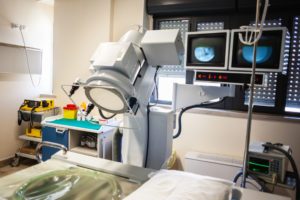
The lithotriptor is used to send high-intensity sound waves to break up kidney stones. Photo: Shutterstock
In this, the second of four posts about common treatments for kidney stones, I’m going to discuss a procedure called shock wave lithotripsy (SWL). If your kidney stone is located inside your kidney and has not traveled down into the ureter, you may be a candidate for SWL.
Interestingly, shock wave lithotripsy came about as the result of an accidental discovery during World War II. After German pilots dropped bombs, they went to assess the damage. They noticed that although the tanks were intact, the soldiers inside the Allied tanks were dead; it turned out that the shock waves produced by their bombs had permeated the tanks.
This inadvertent discovery by German soldiers led to the eventual development of what today is the most common treatment for kidney stones in the U.S.: the shock wave lithotripsy.
SWL, also known as extracorporeal shock wave lithotripsy (ESWL), is a non-surgical technique in which a machine is used to send targeted shock waves from outside the skin to a kidney stone, causing it to break up into “stone dust” or tiny fragments small enough to pass out of the body.
Who is a candidate for shock wave lithotripsy?
Patients whose stones are in the kidney or upper portion of the ureter are the best candidates for SWL. This procedure is used to break up stones that are smaller than two centimeters in diameter. If your stones are bigger than that, or they are lower in your ureters, your urologist will likely recommend a different technique for removal such as ureteroscopy.
Cystine stones and some types of calcium stones are extremely dense and can be difficult to break up, so SWL is typically not used to treat these stones. In addition, pregnant women are never treated with this procedure. It is also not recommended for those who are obese because increased body tissue can make it difficult for the surgeon to target the stone for SWL.
Some other conditions that may take shock wave lithotripsy off the table as a treatment method include general poor health, urinary tract infections, bleeding disorders, the inability to take some types of anesthesia, narrowing of the urinary tract, severe skeletal abnormalities, and cardiac pacemakers.
The shock wave lithotripsy procedure
SWL takes less than an hour to complete, and even though it is a noninvasive procedure, you’ll be heavily sedated. During the procedure, you lie down on an operating table with a soft, water-filled cushion on your abdomen or right behind your kidney. Your body is positioned so that the shock waves can target the stone. The surgeon then uses an ultrasound device to break up the stones, administering up to 3,000 individual sound wave “shocks.”
It can take up to 2,500 shocks to break up the first stone, so depending on how many stones there are and how successfully they’ve been broken up, you may need to repeat the shock wave lithotripsy. A body typically cannot endure more than about 3,000 shocks in one procedure.
What to expect after the procedure
After the procedure, you will usually stay at the facility for about an hour before you’re allowed to return home. You will be encouraged to drink plenty of liquid and strain your urine through a filter to capture any extra stone pieces for testing. You may need to take antibiotics and painkillers for soreness. There may be some bruising on your back or abdomen from the shocks. It is normal to have blood in your urine for up to a few days after the procedure.
When you are fully recovered, you may resume your usual diet and activities unless your doctor advises differently. It is important to follow up with your urologist.
Risks of shock wave lithotripsy
Risks and complications of SWL are rare, but I would be remiss if I failed to mention them. They include urinary tract infections; injury to nearby organs, skin, muscles, nerves, and tissue (minor injuries that typically heal on their own). Some patients may have minimal bleeding in the urine or around the kidney.
Rarely, patients may acquire a condition known as steinstrasse (German for “stone street”), in which a large number of unpassable stones accumulate in the ureter, requiring additional treatment. Another potential risk that is being studied is the development of diabetes or hypertension after SWL. Though the connection between SWL and diabetes or hypertension development is still being debated, it’s worth mentioning so you have all the facts.
Finally, a very few patients may experience stone resistance to SWL therapy despite several attempts to break up the stone. If this is the case, another treatment option will be necessary.
When to call the doctor
If you experience any of these symptoms after shock wave lithotripsy, call your doctor immediately:
- Intense urgency to urinate, even after emptying the bladder.
- Unbearable pain, even after taking pain medication.
If you want to learn more about shock wave lithotripsy—and about how to avoid kidney stones so you never need it—get a copy of my book, Even Urologists Get Kidney Stones. It’s a guide to all things kidney stone, including diagnosis, risk factors, treatment, and prevention.
